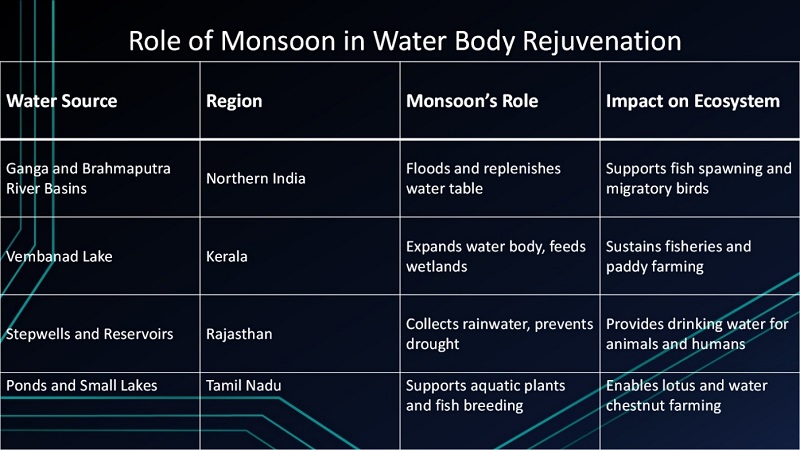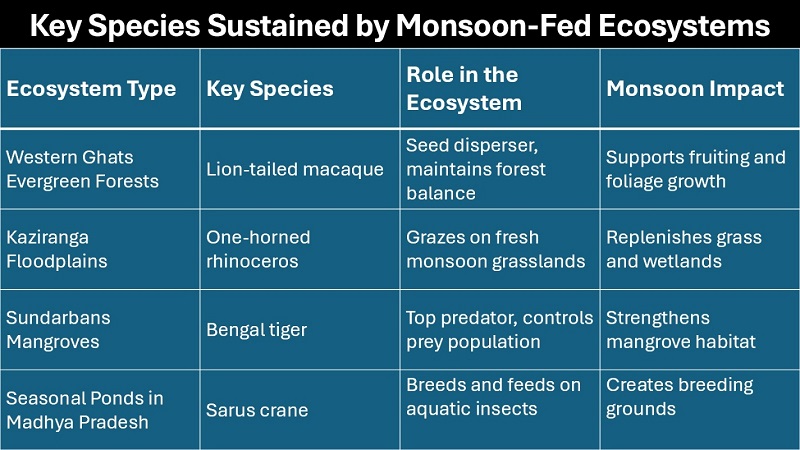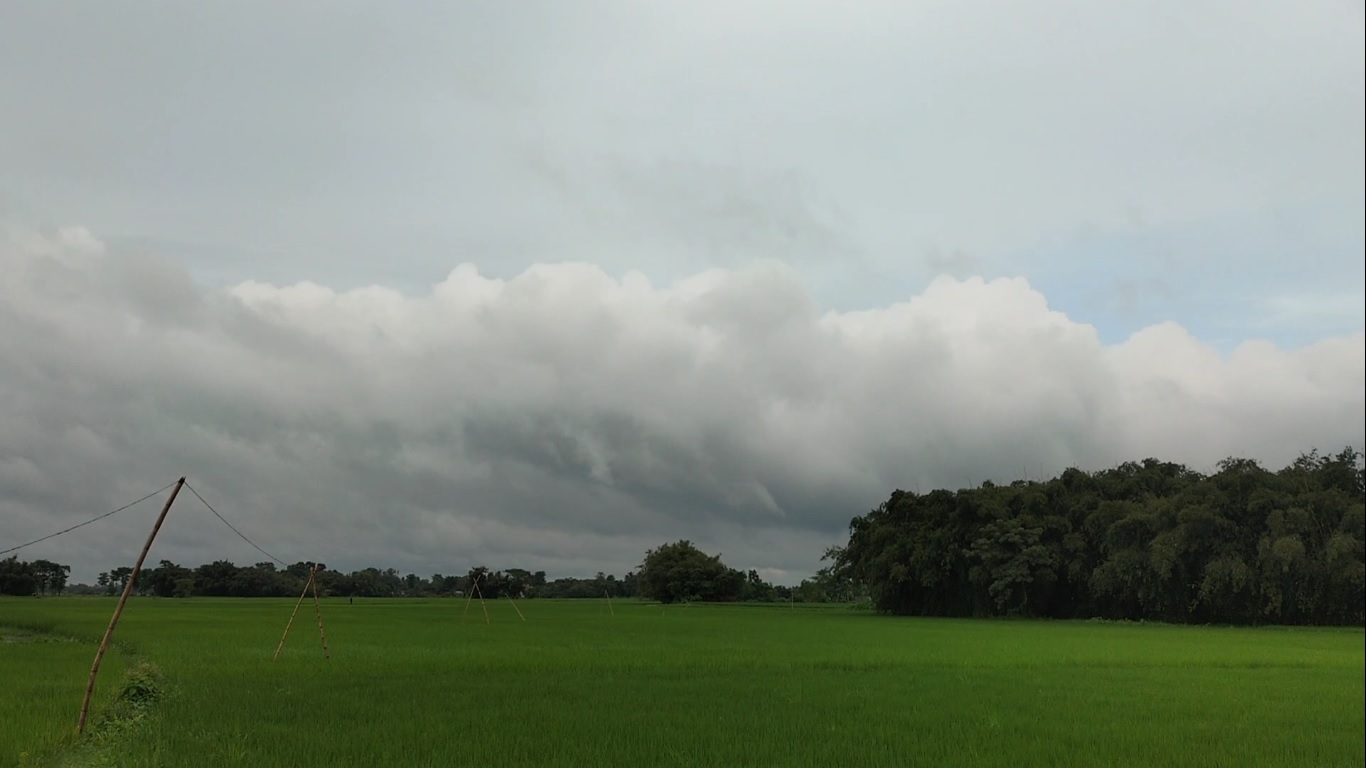Monsoon: An Obscure But Important Season
The Monsoon is a season that does not fit within the four well-known seasons – spring, summer, autumn, and winter. It is an obscure season. Still, it is a crucial season influencing vast regions and almost half of the world’s population. Monsoon is unlike any other season. It can have contrasting effects and feelings. It arrives after the scorching summer and provides much-needed relief from heat. But at the same time, it can cause devastating floods. On the one hand, the rain brings down the temperature, but the high humidity level can still cause unease and sweating. It also has a contrasting smell profile. While the Monsoon brings the sweet scent of blooming flowers and ripening fruits, high humidity can rot vegetation quickly, creating a foul smell.
Monsoons influence many parts of the world. It influences regions such as the coasts of West Africa, Southeast Asia, and Australia. But nowhere is the Monsoon more critical than in South Asia. India depends on this season for agriculture, economy, drinking water, etc. The rain touches almost every part of the subcontinent. Monsoons cover the Western Ghats in thick forests. The Indo-Gangetic plains rely on these rains for irrigation. Even the Thar Desert gets some brief respite when monsoon rain arrives. Even the Himalayas feel its influence as the Monsoon provides vast water from this mountain range in the rivers.
This essay will focus on the Monsoon’s role in creating a sustainable ecosystem in India. It is more than just a season of rain for India. It is a season that sustains rivers, forests, and farmlands and creates its ecosystems. Without it, India would have been a wasteland, moving from extreme heat to cold. For centuries, Indian people, birds, and animals have adapted to the monsoon rhythm and found ways to harness its power. As we explore its impact, we will see how this lesser-known season builds a foundation for sustainability and keeps the cycle of life in motion.

Sustainable Ecosystem Around Rivers, Lakes, and Groundwater
1st June is a significant date for India. According to the Indian Meteorological Department, it is the official arrival date (plus or minus 7 days) of the Southwest Monsoon to Kerala, the Southernmost Indian state. After arrival, the Monsoon generally covers India within 15-21 days. The weather changes from hot and dry to wet and humid with its arrival. Monsoon clouds darken the skies and wet the dry soil. It falls heavy on land, filling the rivers, ponds, lakes, etc. But this is more than just rain. It is a lifeline that revives the entire country and sustains the fragile ecosystems that heavily depend on water.
The Ganga, Yamuna, and Narmada rivers expand in the north with monsoon rains. It carries mud and sludge that is filled with nutrients. The floodwater spread across the planes. It feeds the soil with necessary nutrients and recharges the groundwater. Fish like the Indian carp and rohu start breeding during this time, filling the rivers, lakes, and ponds. The freshwater turtles and river dolphins move freely through the river flow. Various smaller life forms start a new wave of reproduction cycle. Various migratory birds, such as the bar-headed goose and the black-necked stork, arrive in the wetlands and marshlands along the river.
In the south, Kerala’s Vembanad Lake expands as the Monsoon starts getting at its peak. The rising waters sustain various freshwater flora and fauna. It creates ideal conditions for fish like pearl-spot and tilapia. Local fishermen start catching them while herons and kingfishers roam the swamp for food. The lake’s muddy edges become breeding grounds for frogs and insects. They sustain other life forms, such as reptiles and small mammals. Monsoon water not only fills the rivers, lakes, and ponds but also creates and sustains a thriving ecosystem around them.
Monsoon water also refills groundwater levels. In the dry lands of Rajasthan, step-wells and tanks fill with rainwater. It supports hardy crops and vegetation that can thrive on less water. It also gives life to birds like the Indian courser and insects like the jewel beetle. Even in the harsh desert, the Monsoon creates and sustains these ecosystems. These are examples of how the Monsoon creates a sustainable ecosystem around rivers, lakes, and groundwater. It does not simply fill the rivers and lakes. It revives the land and feeds the creatures that depend on it.

Monsoon and the Lush Forests of the Western Ghats
The Western Ghats is a mountain range stretching along India’s western coast, from Gujarat to Kerala. It is a UNESCO World Heritage site that is nature’s treasure trove. Numerous flora and fauna, some of which are endangered, make this place their habitat. Although the Monsoon creates and sustains countless ecosystems in this mountain range, the Western Ghats play a vital role in bringing the Monsoon to Indian shores. So, the Monsoon and the Western Ghats assist and nurture each other like inseparable lovers bonded by nature.
The Monsoon is the heartbeat of this relationship. The rains of the Monsoon provide nourishment to the dense forests. Various species of monkeys, like the lion-tailed macaque, black-footed grey langur, Nilgiri langurs, etc., swing through the canopies of these forests. The Malabar civet, rare and endangered, can be found in these forests at night. Slender loris, another endangered species, is battling to stay alive in these forests. Multicolored Malabar giant squirrels with big fluffy tails can be seen hopping from one branch to another. These creatures depend on the Western Ghats and its trees. And these trees need monsoon rain to survive. Without the Monsoons, forests would be destroyed, and these animals would be gone from the Earth forever.
Western Ghats are also home to many insects, amphibians, and birds. The damp soil and water puddles attract frogs like the Malabar gliding frog, Kottigehar Dancing Frog, night frog, etc., which breed in rain-fed pools. Rare and beautiful insects like Nilgiri Bambootail, Malabar raven, Slowtail Butterfly, Swallowtail butterflies, etc, are found in the Western Ghats. Birds, like the Malabar pied hornbill, Nilgiri flycatcher, Brown Flycatcher, Nilgiri pigeon, Grey Headed Bulbul, etc, survive on the ripened fruits that grow during the Monsoon. The monsoon rains also fill various small streams and ponds that provide drinking water for larger animals like the Indian gaur, dhole, leopard, and even for tigers of the Western Ghats. The Monsoon’s rain holds together this fragile cycle of life.
The Monsoon also gives life to various scattered plantations across the Ghats. These plantations are ancient and are considered sacred by the local people. These groves are home to many rare plants and animals. This plantation is a testament to the vanishing bond between humans and nature.
The rivers born in these forests flow down to the plains. They carry rich nutrients that sustain the agricultural lands. Farmers rely on these waters to grow rice and spices. Various fish and flora thrive in these water streams. The forests also act as a barrier to untamed rain and prevent floods in the farmland.
This is how the Monsoon creates a sustainable ecosystem. It revives the forest, its trees, and the land. It also provides food for the creatures that call the forest home. It also supports humans by aiding farming and fishing.
Floodplain Ecosystems: Life in the Kaziranga and Sundarbans
After drenching the Southern parts of India, the monsoon advances to eastern and central India. It replenishes some of the most important rivers of east India – Brahmaputra, Godavari, Damodar, etc. It sweeps across Sundarbans, an extremely critical mangrove forest in the Bay of Bengal. Then it reaches the northern and northwestern states and refills essential rivers like the Ganga, the Yamuna, the Indus, etc.
In Assam’s (A State in the Eastern parts of India) Kaziranga (Literally means ‘Land of Red Deer’) National Park, the Brahmaputra’s floodwaters fill the grasslands. It leaves behind nutrient-rich mud and sludge. The nutrients feed the soil and allow fresh grass to grow. Majestic elephants roam these grassy fields. They munch on the tender shoots and various other green vegetation. One-horned rhinos feed and procreate in shallow waters. Wild buffalo and swamp deer move through the thick and damp marshland. The floods also create small pools and wetlands where fish and amphibians breed. Various birds, like the lesser adjutant stork and the Bengal Florican, find food in these lands. With its unbound gift of rain, the Monsoon creates and sustains these countless precious ecosystems.
Another critical ecosystem in the Eastern parts of India, the Sundarbans (Literally means ‘Beautiful Forest’), stretches along the Bay of Bengal. Here, the river Ganges meets the seas, and the Monsoon replenishes the mangrove forests. The famous Royal Bengal Tigers are the habitat of these dangerous yet beautiful mangrove forests. Apart from Royal Bengal Tigers, this salty and swampy delta is home to Gangetic Dolphins, Saltwater Crocodiles, Chital deer, Indian civet, Rhesus macaque, wild boar, and many more animal and aquatic life.
The rains wash nutrients from the land into the delta. The water here is a mixture of salty sea and sweet river water. Apart from various nutrients that the river Ganges carries, these lands are also enriched by the nutrients and salt that come from the sea. The roots of the mangrove trees trap the mud and its nutrients. Various tiny organisms feed on this nutrient-rich land. This nutrient-rich food chain supports multiple fish, crabs, and prawns. They, in turn, draw various species of birds and reptiles.
The mangroves and their roots are a barrier against rising seas and devastating storms. Their roots hold the soil and prevent its erosion. They absorb carbon from the air and deposit it in the soil and roots. They directly help in the fight against climate change. The Monsoon strengthens this ecosystem. It rains to keep the mangroves alive. In both Kaziranga and the Sundarbans, the Monsoon sustains life. It revives the land and feeds the animals, birds, and smaller life forms.
Local and Micro Ecosystems Around Ponds, Lakes, and Water Reservoirs
It is not just large ecosystems that the Monsoon creates and sustains. There are innumerable local ecosystems that the Monsoon and its rain create across India, especially in rural India, where the landscape is suitable. When monsoon rains fall, they replenish the small ponds, lakes, and water reservoirs. These quiet and enclosed water systems can sustain thriving and rich ecosystems. These ecosystems can sustain various plants, animals, and birds.
In Madhya Pradesh’s wetlands, seasonal ponds filled with monsoon rains create an ideal habitat for the Sarus crane. These tall and amazing birds roam across these lands and feed on fish and insects. Various species of frogs, spiders, snakes, and small reptiles thrive in these ecosystems. Colorful Butterflies and Dragonflies fly over the water’s surface. The Monsoon allows life to flourish in these water reservoirs long after its withdrawal from the mainland of India.
In Tamil Nadu, various lakes are filled with monsoon rains. They support local communities that farm lotus and water chestnut. The roots of the lotus plant stabilize the soil beneath the water. Its big and broad leaves provide shelter for fish and various insects. Farmers collect seeds and edible plant stems. At the same time, herons and egrets roam these shallow waters for food. In a delicate balance, the Monsoon sustains both nature and human livelihoods.
In Rajasthan’s dry regions, ancient step-wells and artificial tanks collect rainwater during the Monsoon. These water reservoirs attract birds like the Indian courser and desert wheatear. In rural areas of West Bengal, the Monsoon fills the rice paddies, ponds, and puddles. Rural people sow rice in these lands. They harvest various fishes like rohu, putti, bata, tilapia, mrigal, etc. These enclosed water systems are a breeding ground for multiple species of snakes, frogs, insects, small mammals, and birds such as Dahuk (White-breasted Waterhen Bird), Jal pipi (bronze-winged jacana), etc.
The Monsoon shapes these small, watery, and muddy ecosystems. They are fragile yet essential and enduring. With the help of monsoons, they nurture complicated ecosystems that are important to restore the balance between humans and nature. Both humans and nature benefit from them.
Conclusion: Monsoon Sustains An Entire Nation
From the Brahmaputra’s floodplains to the Sundarbans’ mangroves, the Monsoon sustains ecosystems that cannot survive without rain. It fills some of the most important rivers in India, such as the Ganga, Godavari, Narmada, Kaveri, Krishna, Yamuna, Brahmaputra, etc. It allows various fish species and other aquatic animals to thrive in its water. It sustains numerous species of migratory birds. It revives the lush forests of the Western Ghats and supports a plethora of endangered species.
It fills the ponds and lakes of rural India and creates a sustainable ecosystem that benefits humans, birds, insects, amphibians, reptiles, and animals. But monsoon rains do not just fill the rivers, ponds, and lakes on the surface. It also recharges groundwater reserves. These reserves are key to sustaining life through the dry months.
Without the Monsoon, these delicate ecosystems would fall apart on and beneath the surface. The soil would dry, and the rivers would shrink. Life would struggle to survive without water. The Monsoon is ancient and relentless, holding an entire nation and the continent.
However, the life-giving Monsoon is threatened by human-induced climate change and global warming. The Monsoon is becoming erratic and unpredictable. During the El Nio years, the monsoons registered below-average rainfall, contributing to severe droughts in many parts of India. Global warming and climate change create devastating cyclones in the Bay of Bengal and the Arabian Sea. These weather systems are formed just before the arrival of Monsoon (May-June) or at the fag end of it (October-November). Apart from causing stupendous destruction, these cyclones take away all the moisture from the Monsoon winds and can negatively impact its arrival and stability.
Nowadays, the use of monsoons has also become unreliable. Even with normal rainfall, Monsoons can have a wide range of regional variations, causing floods in some parts of India and creating drought-like situations in other regions. It may happen that one area was experiencing drought during one particular month. Then suddenly, that region may receive rainfall for the entire month in just 2-3 days, causing destructive floods.
All these erratic behaviors of the Monsoon are disrupting the natural ecosystems. On the one hand, the extreme heat of the drought evaporates the water reservoirs, rivers, lakes, and ponds, threatening the survival of many endangered species of animals, birds, insects, amphibians, fishes, etc. On the other hand, the flooding is causing soil erosion and destruction of their natural habitat. It is crashing any hope of their rejuvenation or revival. Without the rains of the Monsoon, the Indian subcontinent faces the threat of becoming a barren land with extreme heat (in the Southern and Central plains) and freezing temperatures (in the Mountainous North).




